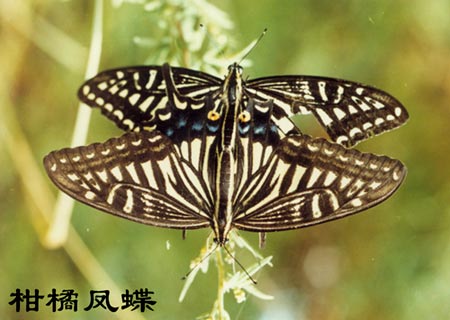Alias of citrus swallowtail butterfly: orange swallowtail butterfly, swallowtail butterfly, pepper swallowtail butterfly, swallow swallowtail butterfly, swallowtail butterfly, orange swallowtail butterfly.
Adult: wingspan 90-110 mm. The color of the body and wings changes with the seasons: the spring type is light and dark brown, and the summer type is dark and black. The patterns on the wings are yellow-green or yellow-white, and the arrangement is the same for both the spring and summer types, except that the summer-type male butterfly has an extra black spot on the front edge of the hind wings. There are 4 to 5 radial markings on the base half of the middle chamber of the forewing, which are almost connected to the end. There are 2 horizontal spots on the end half; there is a row of crescent-shaped markings on the outer edge area; there is a row of longitudinal markings on the middle and rear area. , the outer edges are arranged very neatly and regularly, increasing one by one from the front edge to the rear edge. To the cu2 chamber, there is a longitudinal band extending from the wing base. The band is angularly bent in the middle and has a hook-shaped end; along the trailing edge There is also a thin vertical stripe. The markings on the base half of the hind wings are arranged along the veins and divided by the veins; there is a row of blue spots in the sub-outer edge area, sometimes not very obvious; there is a row of meniscus-shaped markings in the outer edge area, and there are 1 ring or semi-ring red markings. The reverse side of the wings is slightly lighter in color, the sub-outer areas of the front and rear wings have obvious markings, and the rest are similar to the front side.

The eggs are oblate, about 1 mm high and more than 1 mm wide, smooth and shiny. It is yellow at first birth and turns purple-gray later.
larvae 5th instar. The body length of the first instar is about 3mm, the head is pitch black, the trunk is slender, dark brown, the 1st to 6th segments are dark yellow, and the sarcoma around the 1st segment is extremely large, with thin dark yellow bands and stinging hairs. There are yellow-white diagonal stripes on the 6th and 7th segments of the grown larvae, and there are sarcomas and yellow-brown stripes on both sides of the back. They spin silk and are fixed before peeling. The body length is about 5mm. The fifth instar larvae is about 17mm long, with a yellow-green head, grass-green back and sides, and horizontal stripes; there is a large black stripe on the rear edge of the 4th and 6th segments, and there are yellow stripes on the base of the feet; the 4th and 6th instar larvae have a body length of about 17 mm. Each segment 7, 8, and 9 has orange-yellow dots; segment 1 has a pair of odoriferous glands, which are orange. Mature larvae are approximately 40 mm in length.
Pupa: Body length is about 30 mm. The body is light green and slightly dark brown. There is a significant protrusion on both sides of the head, and the chest and back are slightly pointed.
This species is very similar to Papilio machaon Linnaeus. The main difference is that this species has radial markings on the middle chamber of its forewings, and the markings on the base half of the hind wings are widely spaced from the middle chamber. The Papilio machaon Linnaeus has no radial markings on the middle chamber of its forewings. The distance between each wing spot and the middle chamber is narrow. The structural differences between the external genitalia of male and female butterflies are very obvious.
Host: Poncirus trifoliata of the Rutaceae family, eating Cornus officinale, Zanthoxylum bungeanum, Evodia, Astragalus, Citrus and other plants.
Biology: Three generations occur in a year, overwintering as pupae. The overwintering adults appear in May and June, the first generation in July and August, and the second generation in September and October, but the emergence is not neat enough. Adult insects fly to flowers to collect nectar and mate. Eggs are laid on the underside of young shoots and leaves, and are laid in pellets. After hatching, the larvae feed on the buds and leaves, with a jagged shape, and sometimes feed on the main veins. It lies on the main vein during the day and harms food at night. When it is frightened, it protrudes the odorous gland from the front side of the first segment and releases odor to repel the enemy. The pupae stand obliquely on the branches, one end is fixed, the other end is suspended, and silk is wrapped around the branches.
Distribution: Endemic to East Asia, found throughout China; Japan, South Korea, and Myanmar.
animal tags:
We created this article in conjunction with AI technology, then made sure it was fact-checked and edited by a Animals Top editor.